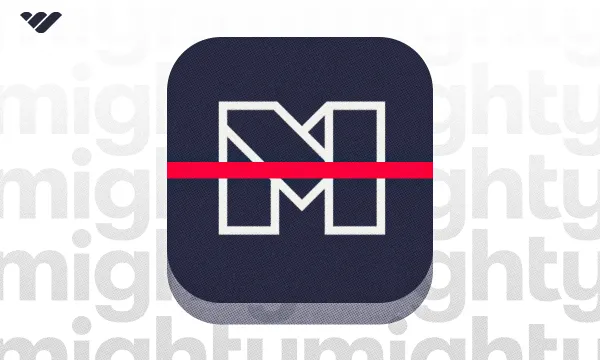Gumroad vs. Payhip - which platform would you choose for selling digital products?
This is a common question that many creators ask themselves. If you're running your own business then you know firsthand how challenging it can be to find the right platform or service for your business operations. There are so many options on the market, but choosing the wrong tool can be expensive - and could even derail your revenue potential.
Both are excellent choices and competitors in the market. But which is right for you? There are so many factors to consider, and finding the answer can often be confusing. So, let's take a closer look at both Gumroad and Payhip so that you can understand which platform better suits the needs of your business.
Gumroad vs. Payhip: What's the Difference?
Both Payhip and Gumroad are ecommerce platforms for selling digital products, with Payhip offering more customization options and Gumroad offering a smoother setup experience. Let's take a quick look at what each of these platforms offers, from platform type, to features, to fees.
What is Gumroad?
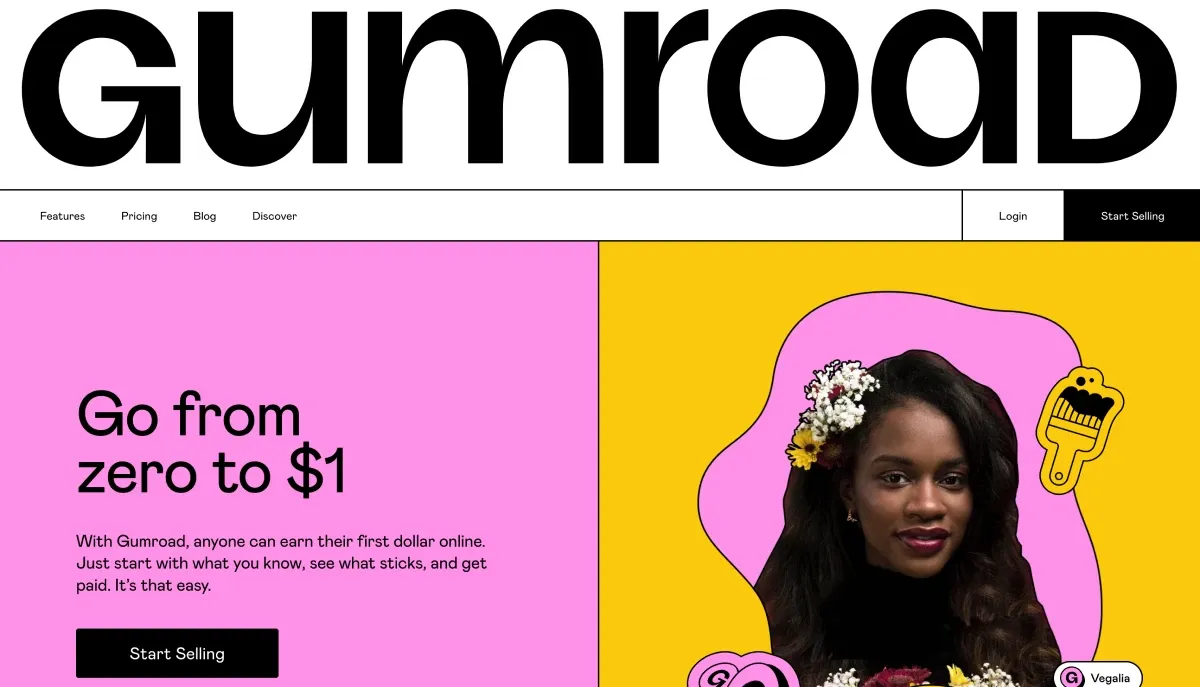
Gumroad is an ecommerce platform enabling creators to sell their products directly to their fans. Creators can sell various products, including eBooks, music, videos, software, memberships, and even physical products like art and clothing.
Gumroad was established in 2011 by Sahil Lavingia; the company is headquartered in San Francisco, California.
Who Can Use Gumroad?

The platform itself is quite large, professing that it has over 156,000 creators who have earned over $800,000,000.
Gumroad's target audience is independent creators who want to sell directly to their audience without using a bunch of intermediate services and products, whether that is selling crypto tips, cookbooks, emojis, or anything in between.
How Does Gumroad Work?
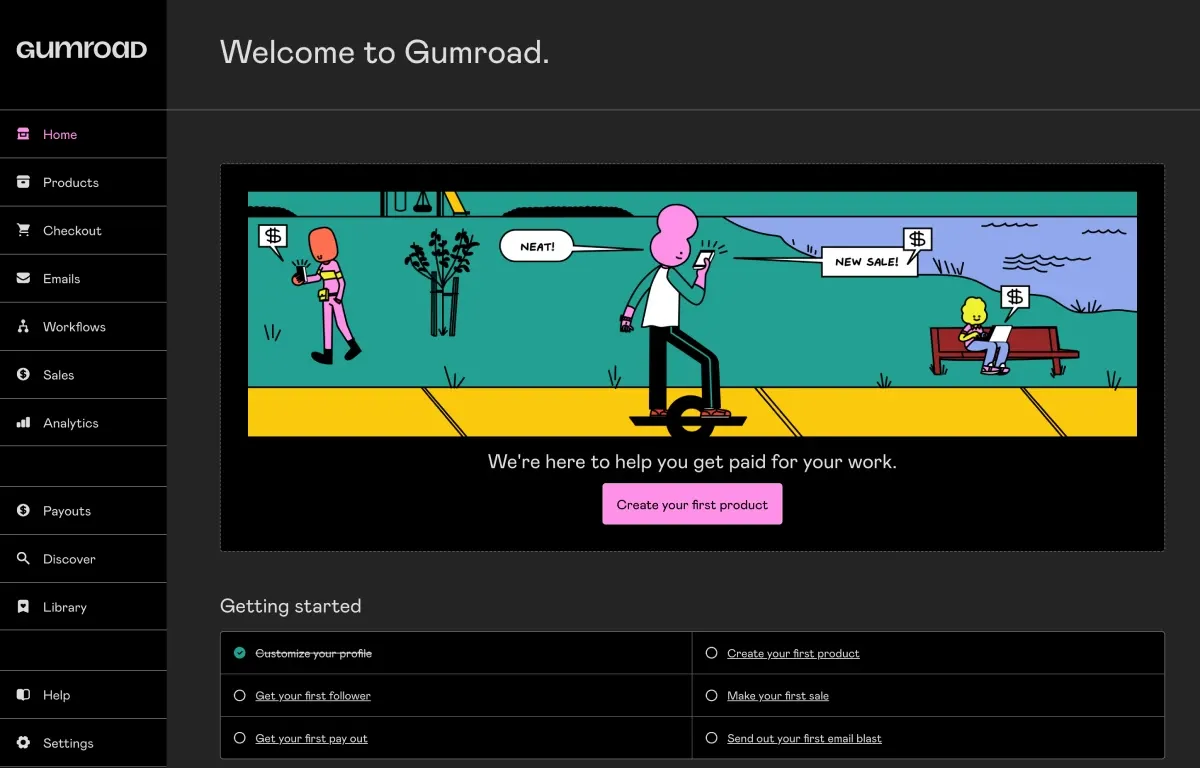
With Gumroad, a creator can create a custom landing page, track their sales, and process their payments directly on the platform. Users can use the page editor to build a storefront on Gumroad and customize the site's appearance to reflect their brand. If the user already has a website, they can simply link the site to Gumroad with a custom domain.
Using Gumroad, creators can make memberships and set up subscriptions. Gumroad also accepts payments in different currencies to accept a global audience. Additionally, Gumroad offers data analytics, automated workflows, and also email marketing capabilities.
Let's take a closer look at the process of selling products on Gumroad.
Selling on Gumroad
When you begin as a seller on Gumroad you're first led to creatte your account. Then, you select the product you want to sell from the 'Products' tab - 'Digital Product' for a set of files to download or stream, or courses, tutorials, or even physical goods. It's clear to see from the outset the type of products that you can sell on this platform.
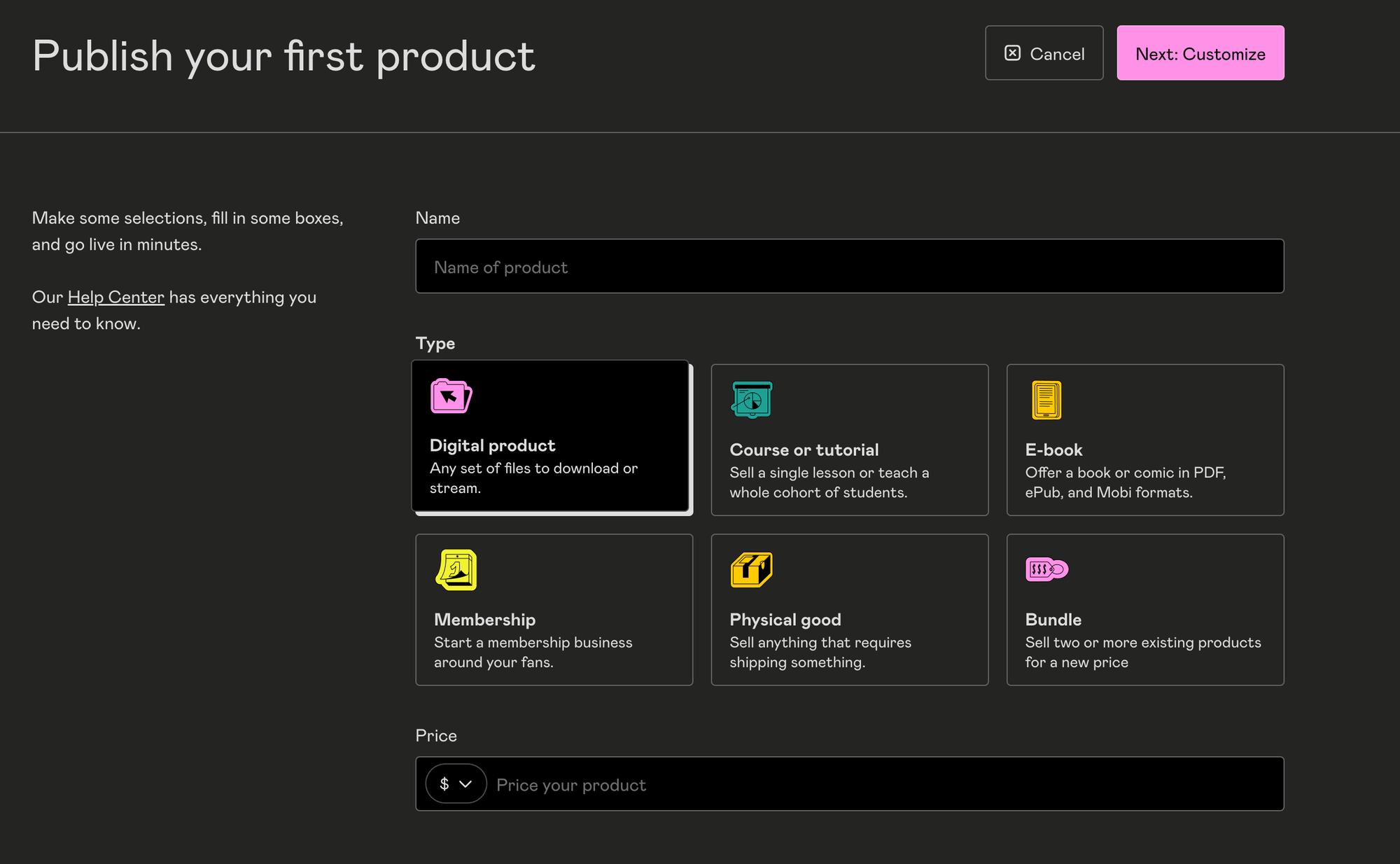
From here, setting up your product page is pretty straightforward. You can input the name, set up a description of your product offering, create a URL or add a custom domain, and add your cover image.
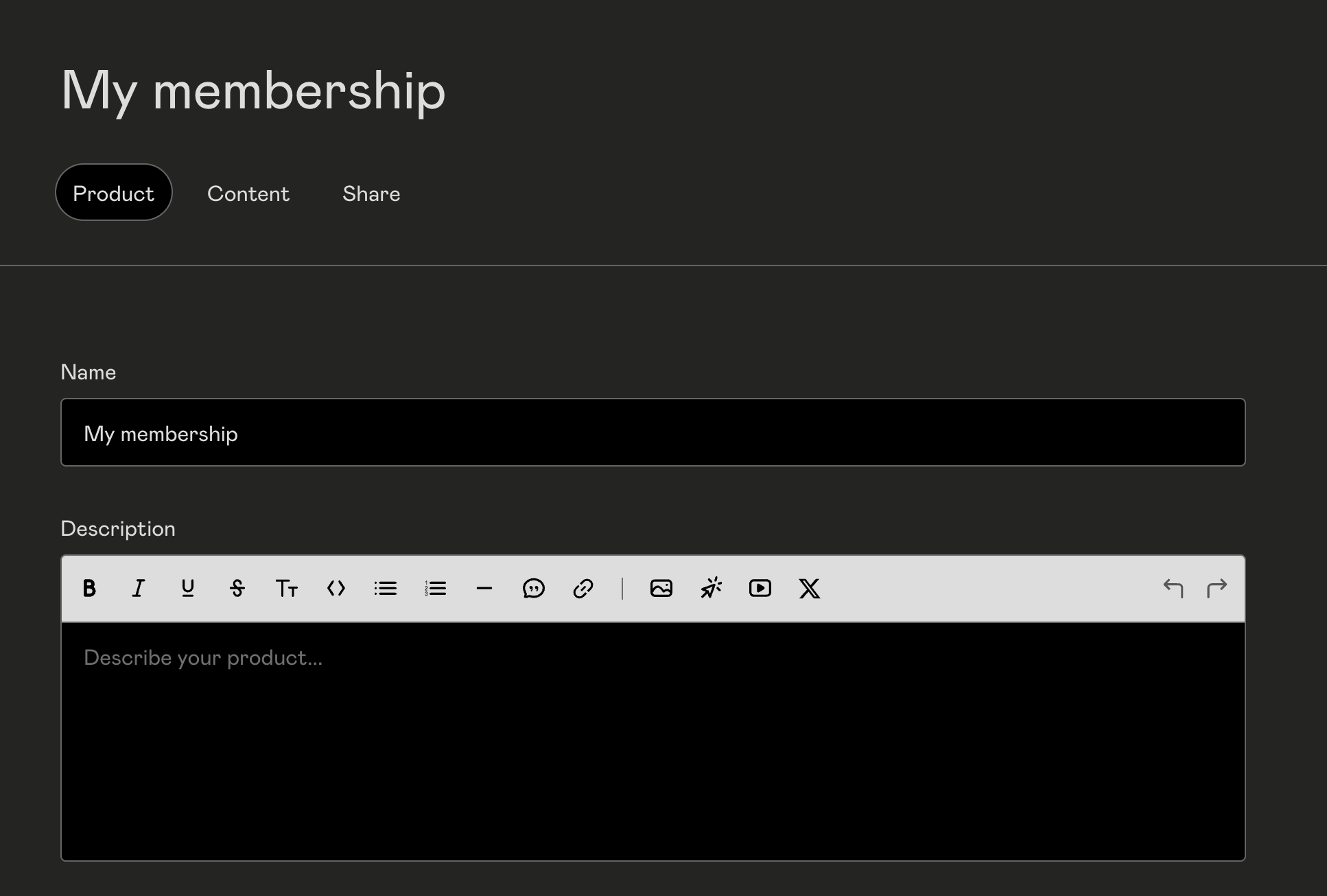
On the same page, you can add the summary of your product and any additional details for potential customers to read through. Then, you can integrate your Discord or Circle community with Gumroad.
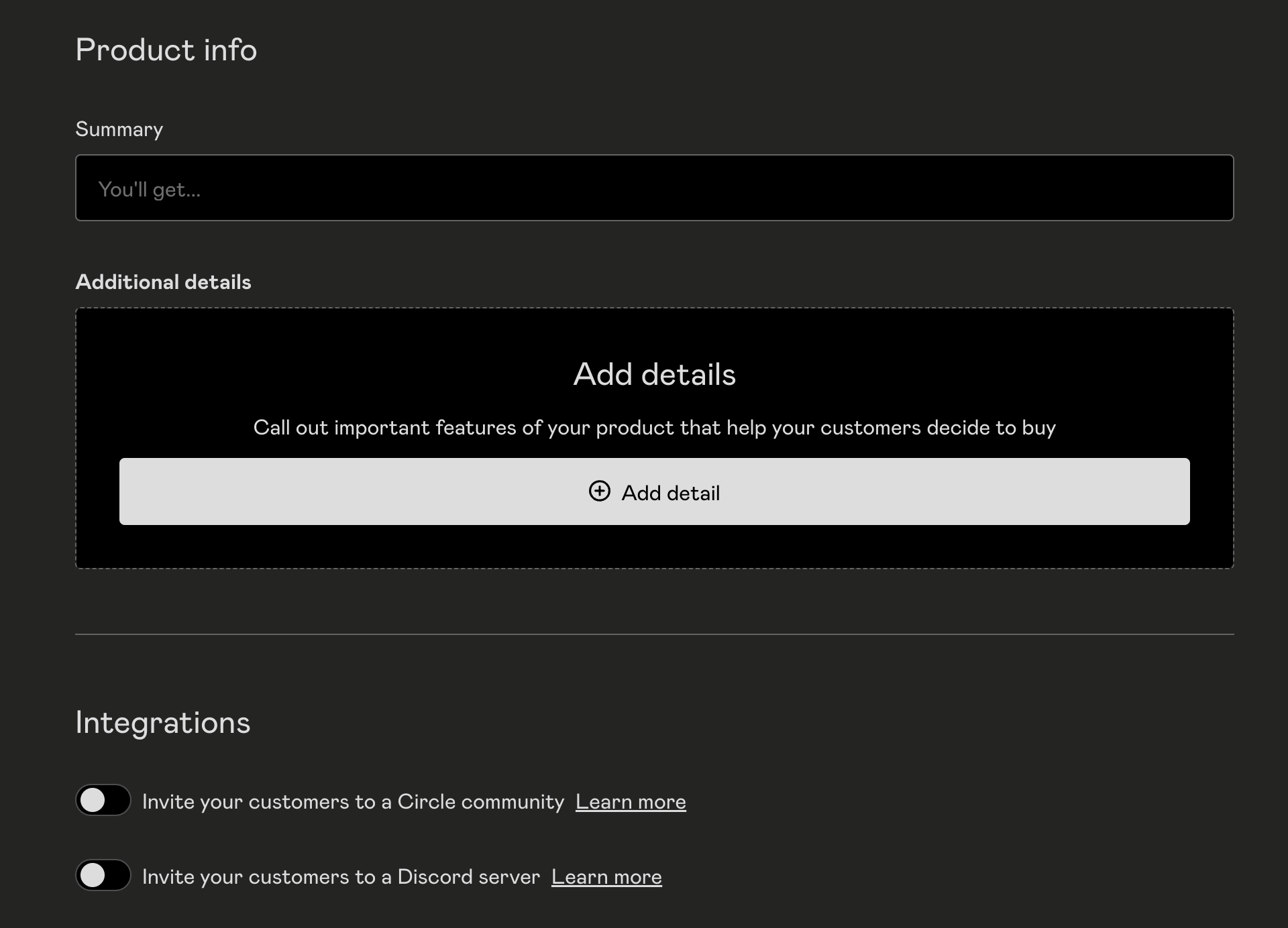
The setup process differs slightly based on the type of product that you are selling. For example, if you're selling a membership then you can set up membership tiers, if you're selling a physical good you can add shipping destinations and SKUs, and with courses and eBooks you can offer alternate versions of the product. However, the setup process is mostly the same across all products.
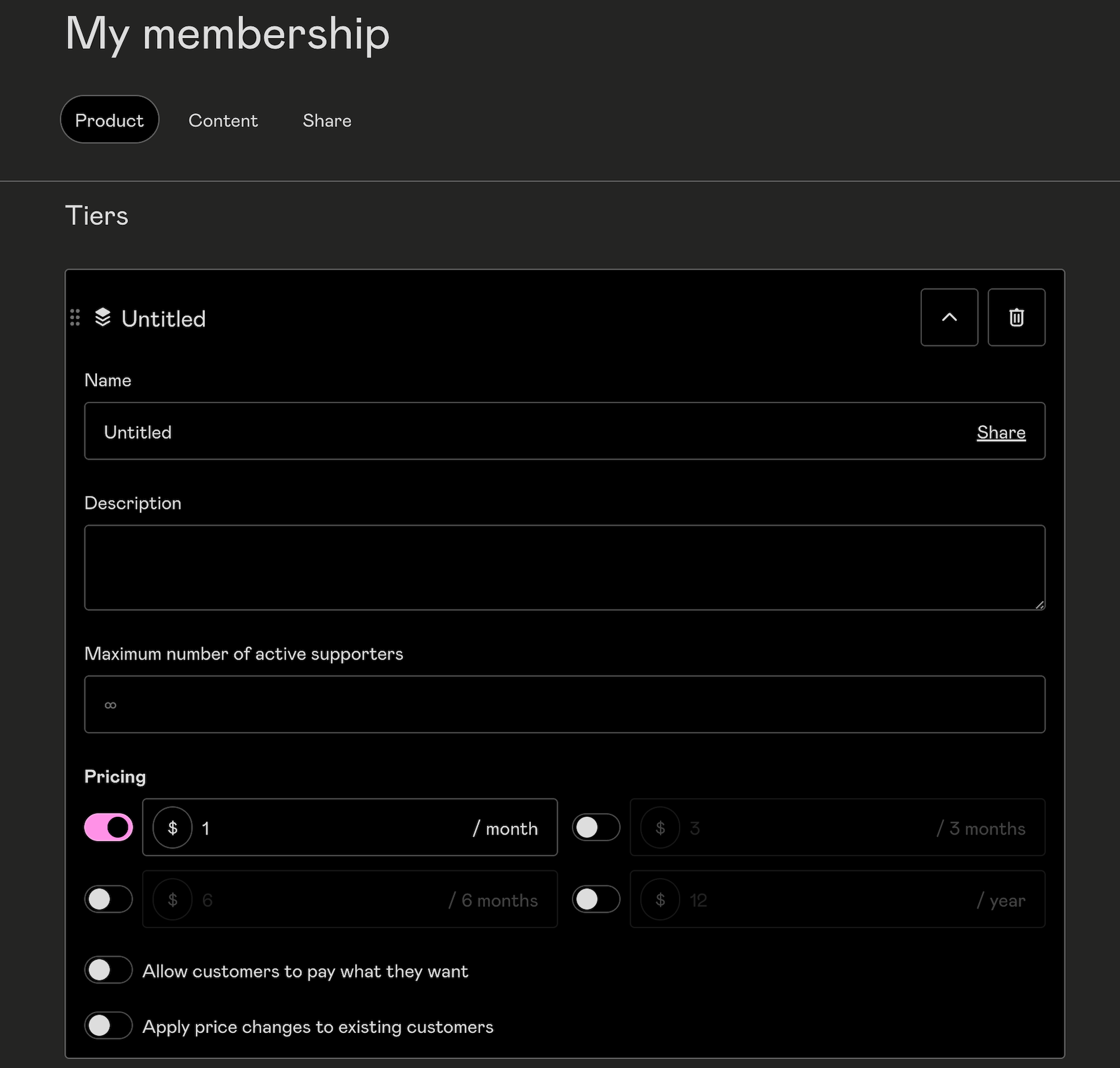
Overall, setting up a product offering on Gumroad is a straightforward process where you can set up product information, pricing, deliverables, and (if relevant) membership options all in one place. You can even preview your page before it goes live, so that you can see if you need to make any edits to your Gumroad product page before hitting publish.
Platform Customization
Although the platform itself prompts you to 'customize' your product page, the customization is actually very limited. You can upload a cover for your product page, upload a thumbnail, and add your product summary, CTA, and any additional details.

That's about it. So, you are not able to edit the colors, font, or general design of your product page.
However, one nice touch is the customization options for your checkout page.
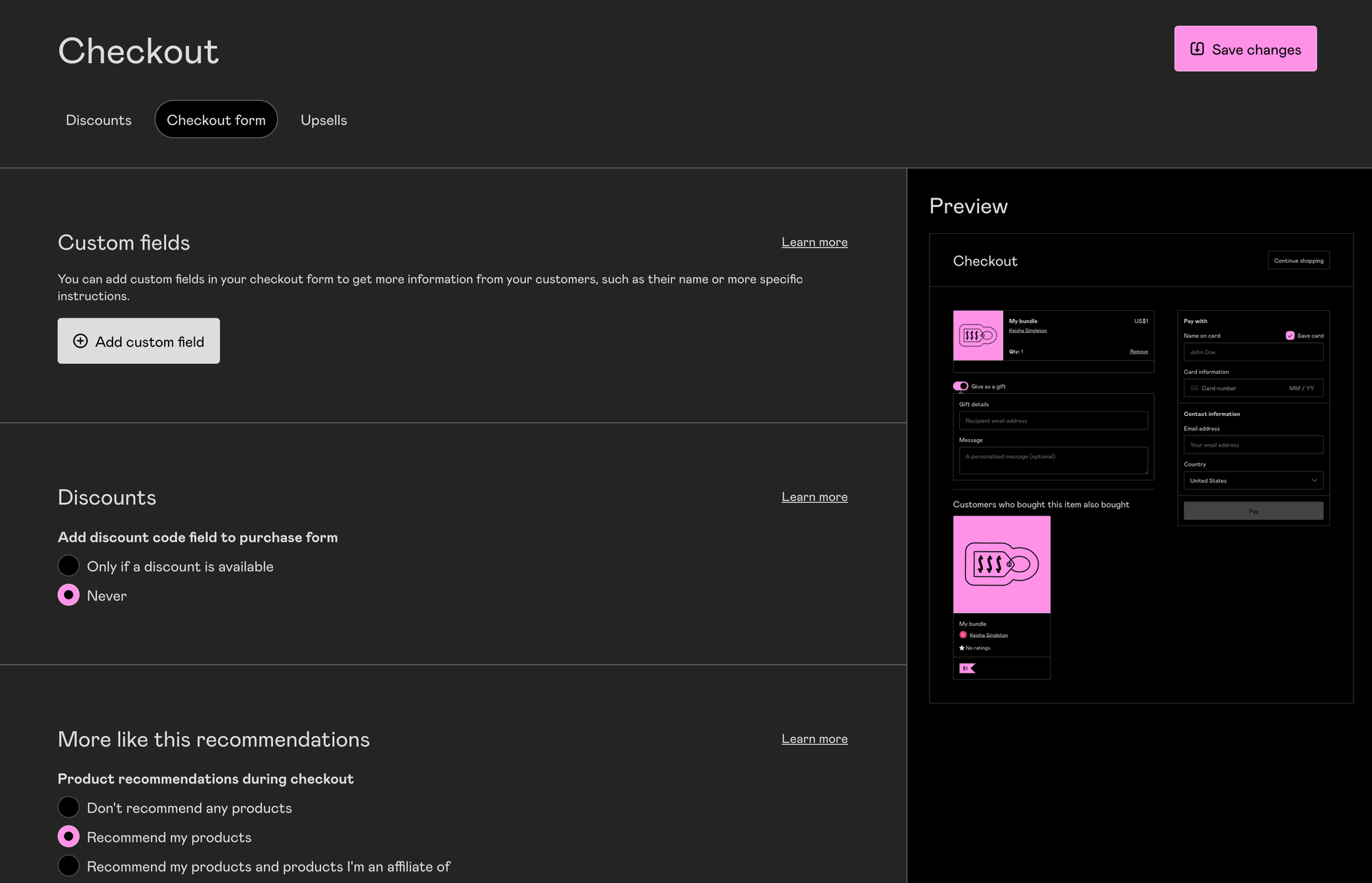
Here you can add custom fields in your checkout form to get more information from your customers (important if you are selling personalized products), offer discount codes, recommend your other products, and offer an upsell or product add-on at checkout
Customer Engagement Tools & Customer Management
Gumroad has an 'audience dashboard', so each time a new customer purchases one of your products they are added to the 'customers' tab of your audience dashboard, or, if they follow you from your profile, they are added to your 'subscribers' tab. In this dashboard, you can review all of your customers and manage your audience information.
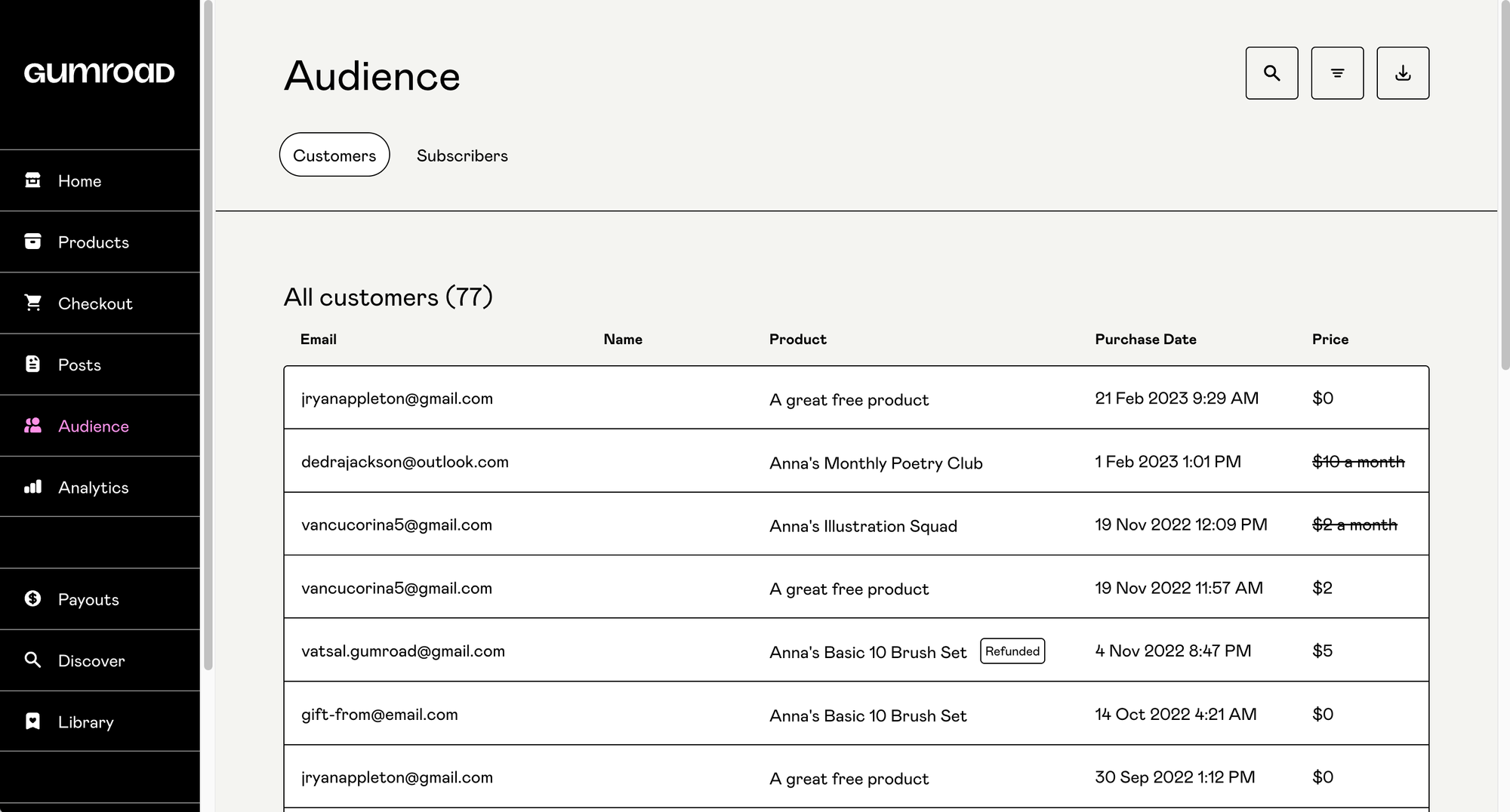
Gumroad gives you the option to search by customer name or email address and filter by what they have/haven't bought, price, purchase date, the country they are in, or if they are an active user or not (active user is someone who has either not had a refund or not ended a membership).
This is a pretty handy tool, as here you can edit a customer's email address, select if a customer wants to receive your posts, update shipping information, and manage license keys. You can also cancel a membership, refund a customer, resend posts and receipts, and export sales CSV.
Customer Support
One huge downside to Gumroad is the lack of customer support that they offer. The 'contact Gumroad' page leads to a list of the issues that the platform can and can't help with.
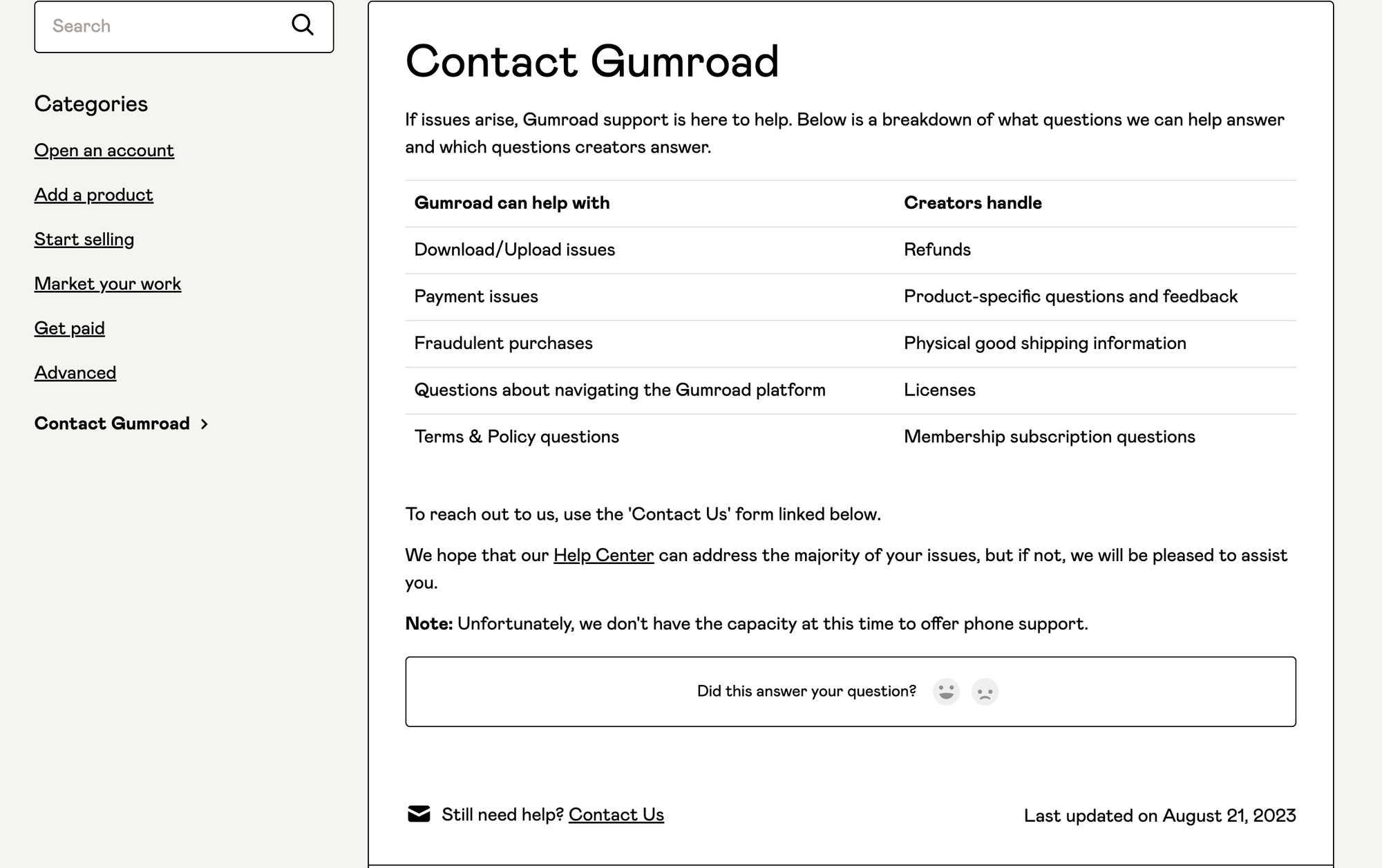
While Gumroad will help with download and upload issues, payment issues, fraudulent purchases and questions about using the platform, everything else is in the hands of the creator. That means that the creators themselves must take care of refunds, product questions, physical shipping, licenses and membership subscriptions.
Plus, Gumroad can only be contacted via online form. There is a 'Help Center' that directs to various articles on commonly asked questions, but other than that you must use the linked form. There is no way to contact Gumroad via phone.
How Much Does Gumroad Cost?
The platform doesn't charge any monthly fees. Instead, creators are charged a 10% flat transaction fee for every sale. Credit card processing and PayPal fees are on top of this.
What is Payhip?
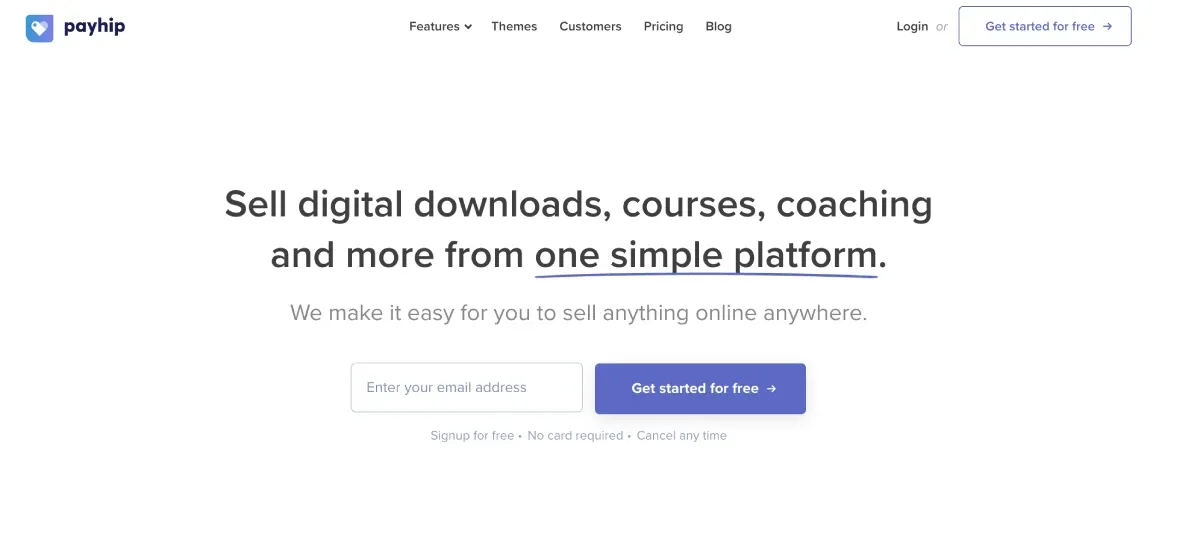
Like Gumroad, Payhip is an ecommerce platform for creators who want to sell products to their followers. As of January 2024, Payhip states it has over 130,000 creators using its platform. Some of their customers include Tiktok blogger Tyler Tucker and award-winning author Sebastien de Castell.
The company was founded in 2011 and is based in London.
Who Can Use Payhip?

Payhip targets creators exclusively. The platform states, "We're an all-in-one e-commerce solution for creators. Whether you're an author, designer, YouTuber, blogger, poet, knitter, painter, musician, podcaster, consultant, teacher...we are here to help you make a living doing what you love." Anyone selling digital downloads, courses, membership, and physical products can sell on Payhip.
How Does Payhip Work?
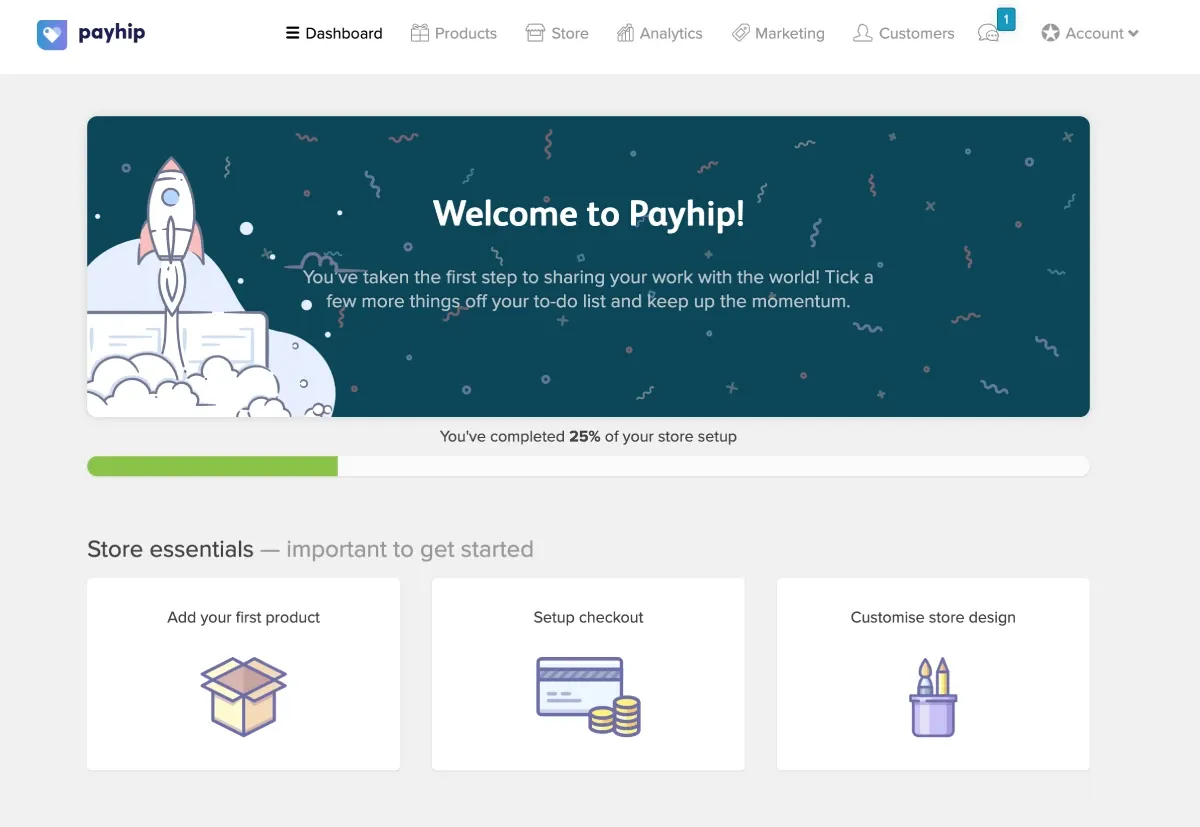
Creators using Payhip can sell digital products, courses, coaching, memberships, and physical products. Payhip offers a customizable store website builder, so creators can connect their own custom domains to the Payhip platform or embed a checkout on their existing websites.
Sellers on Payhip can upload files in all formats, including audio files, video files, text files, and files with any extension. Courses are sold in a customizable, branded course player, memberships can be sold in multiple tiers, and payments can be accepted via PayPal and Stripe. Further, Payhip offers built-in marketing tools like coupons, affiliates, and referrals.
Here's a deep dive into the process of selling products on Payhip.
Selling on Payhip
Like Gumroad, once you've created your Payhip account you are brought to your seller dashboard. The dashboard is clean and easy to read, highlighting the steps that you must take to set up your online store. The store setup bar is a nice touch too, showing you how far along you are on your ecommerce journey
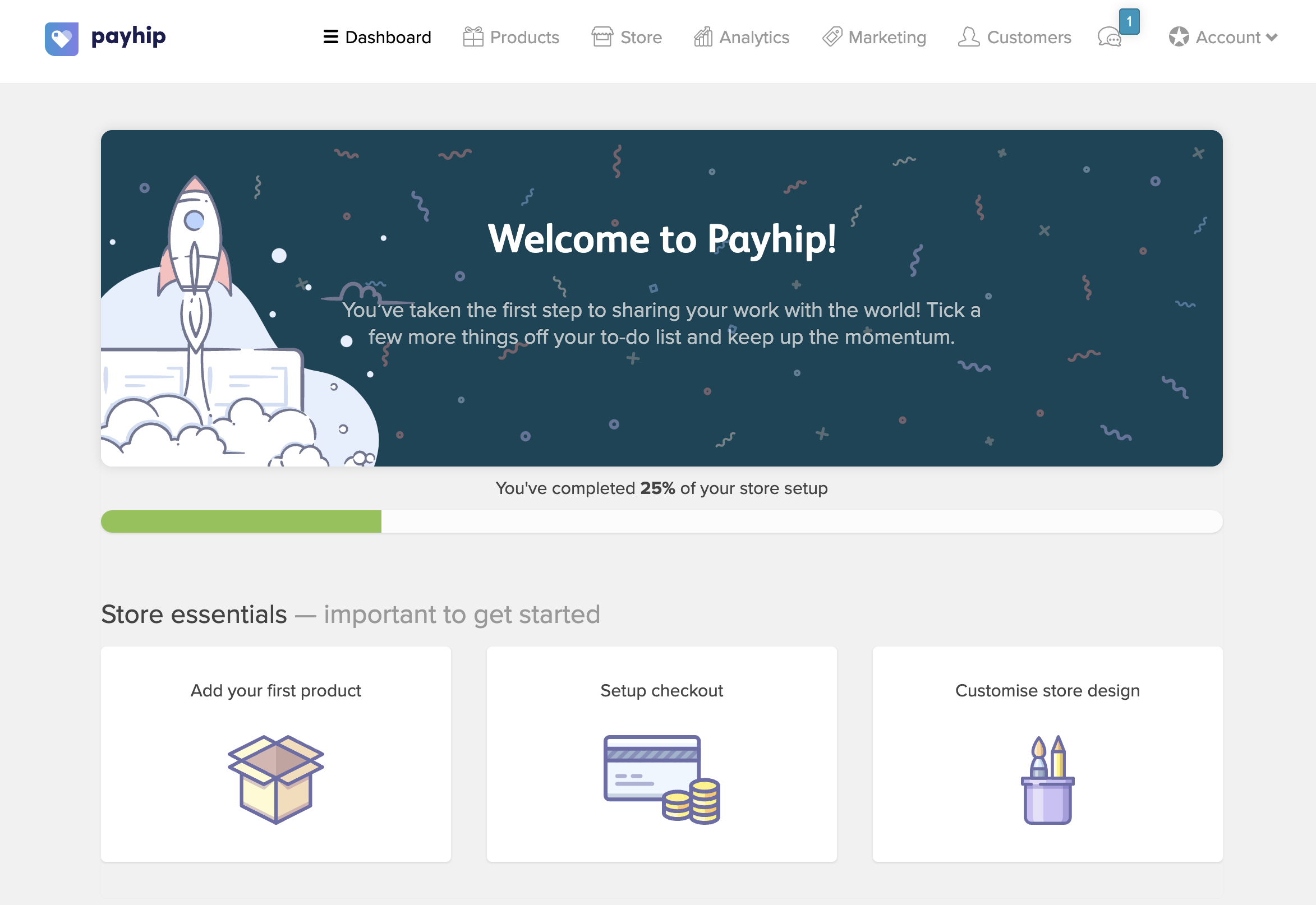
Adding a product seems straightfoward. You start by clicking 'add a product' and the platform outlines what steps you will take in this section, including giving your product a name, price, and 'a few other details'.
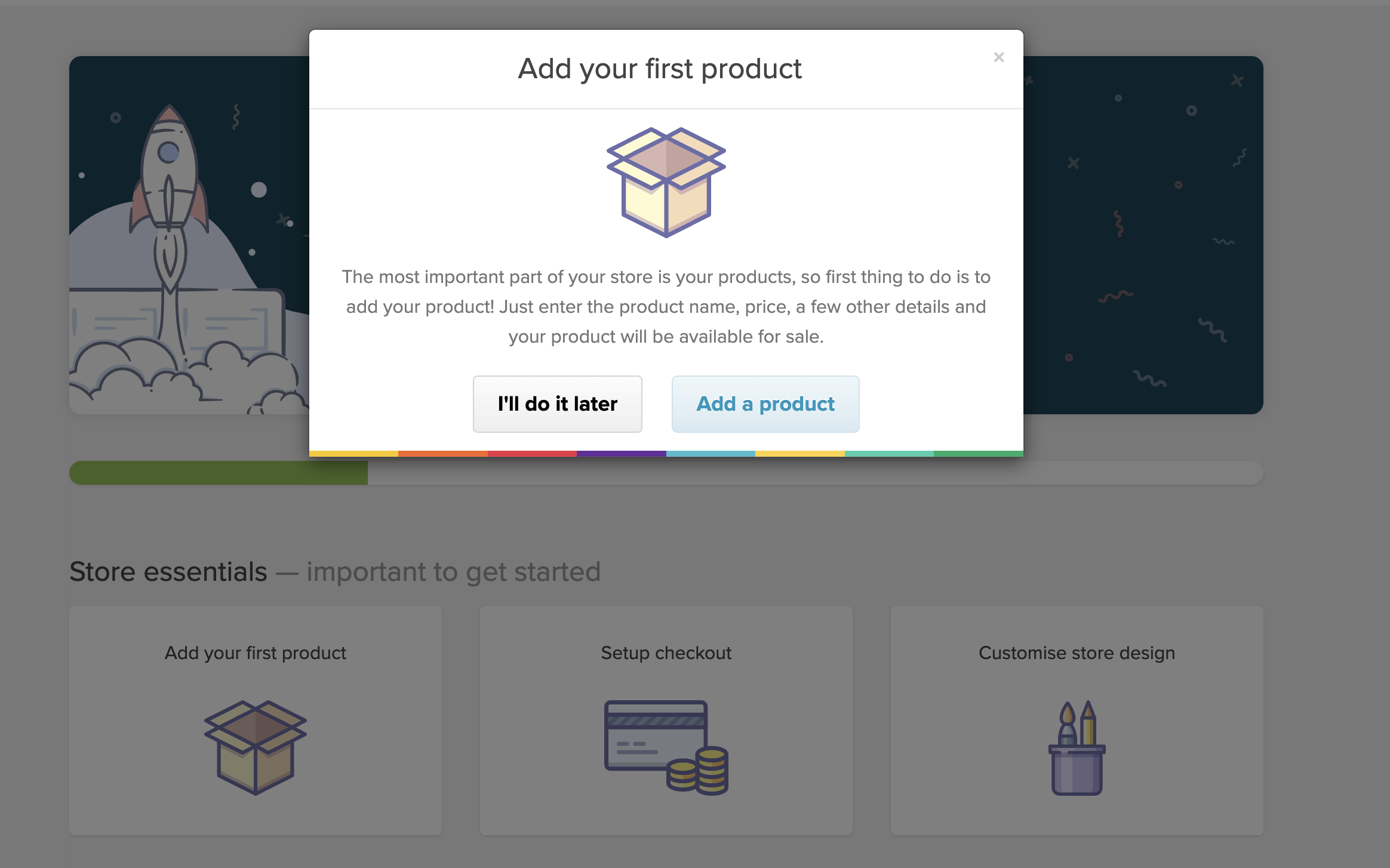
Once you have clicked through you come to a page where you select your product type. Like Gumroad, you can choose 'digital product', 'course', 'membership', 'physical product' and 'bundle'. One extra option here is 'coaching service'.
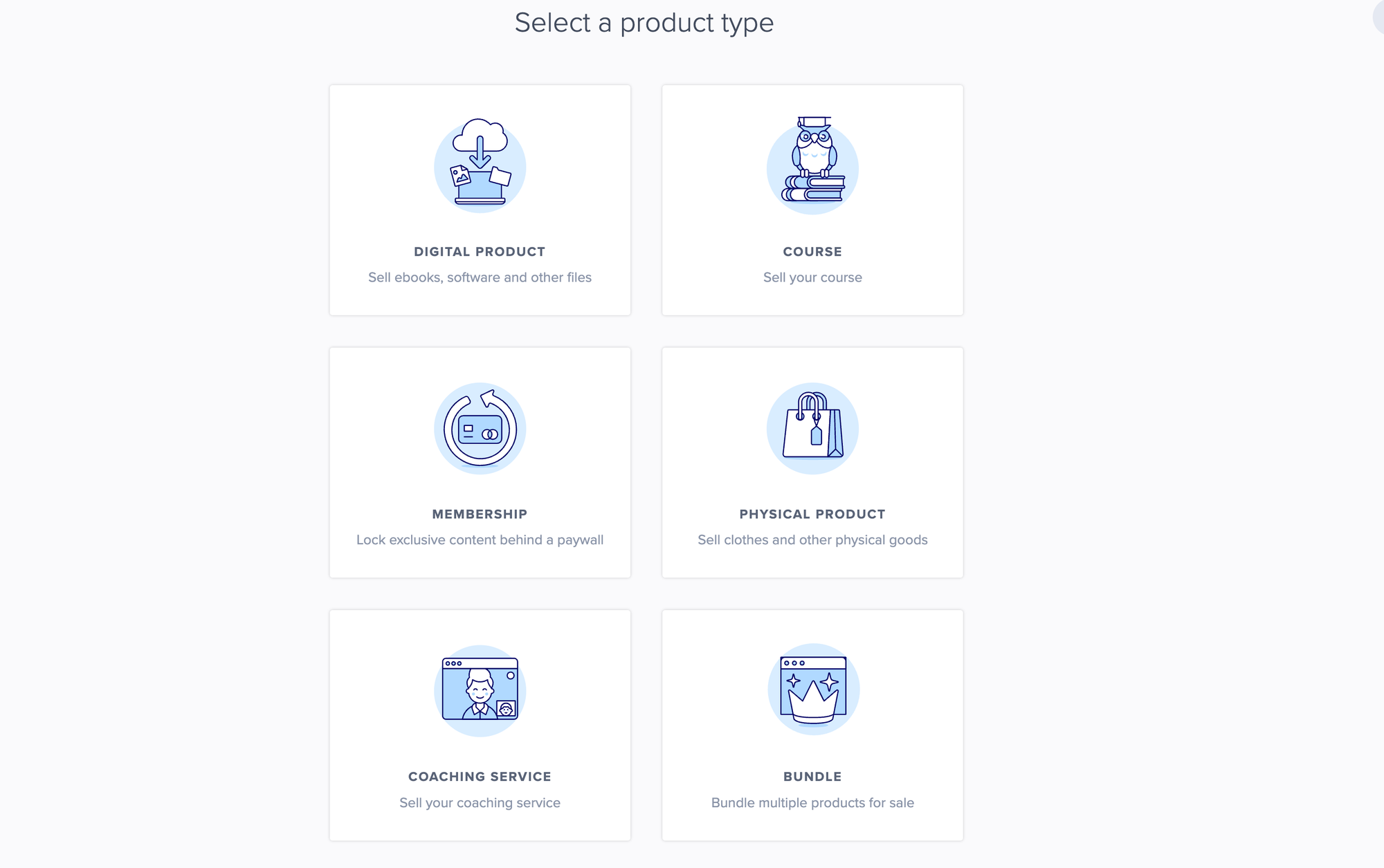
The process of adding a digital product is extremely simple. You upload the product file, choose a title, set a price, and add a cover image and description. You can also choose the visibility of your product - it can be visible to everyone, no one but you, or 'unlisted' so only those with a direct link to the product can see it.
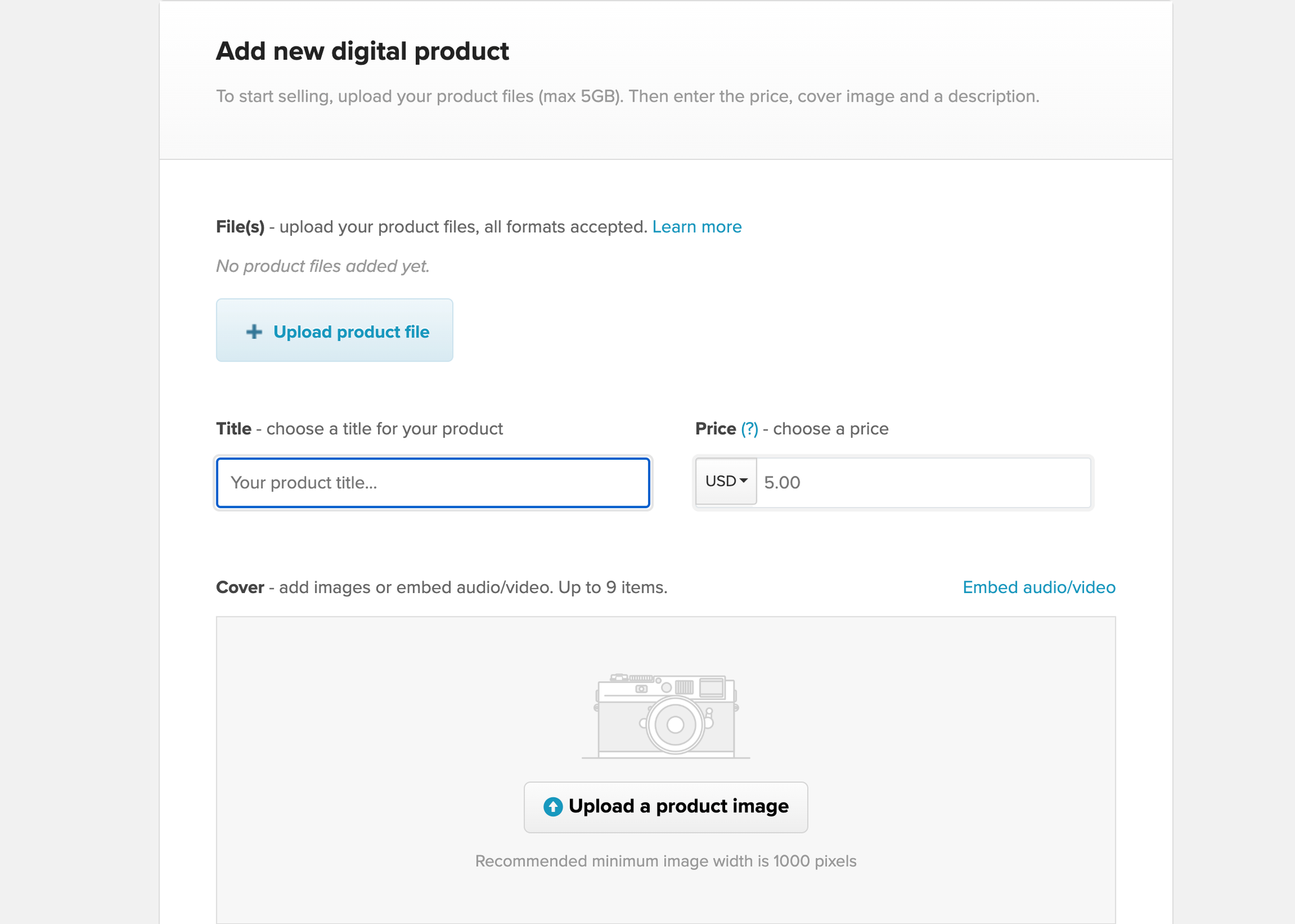
Advanced options include uploading different variations, marking a product tax exempt, reducing the EU VAT for eBooks (where applicable), limiting the number of times a product can be sold, automatically subscribing customers to a mailing list, and generating unique license keys for the sale of software products.
Unlike Gumroad, the product setup options have a lot of differences between the product types. For example, if you're setting up a course, then you start by adding the title and then adding in your course units.
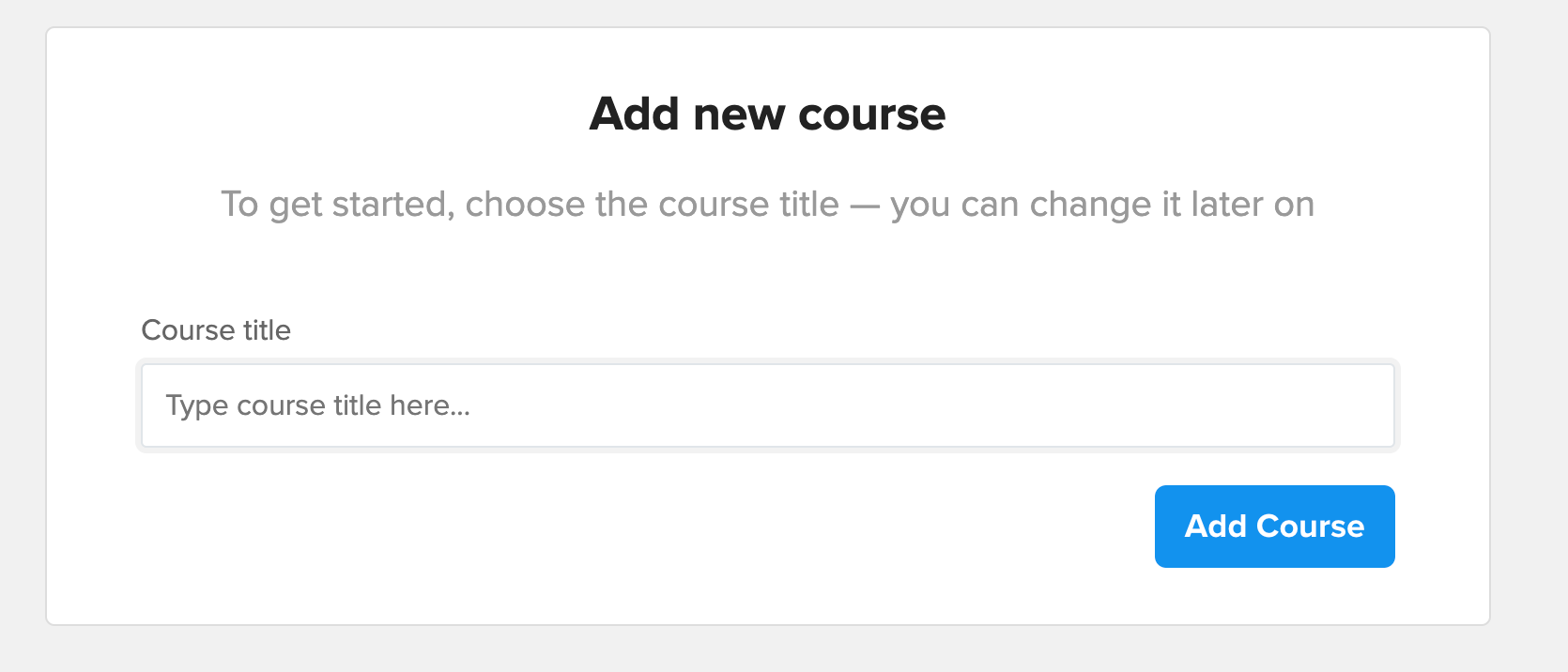
Once you have added your course as a product, you navigate to the bar along the top to upload your thumbnail and author details, add pricing plans (one-time purchase, subscription, payment plan, or free), add certificates for those who complete your course, and create a video library. Here you can also set drip schedules to release your content to students over a period of time.

One issue with Payhip is that if you want to sell memberships through the platform, you are selling a membership to gated content such as blog posts and videos.
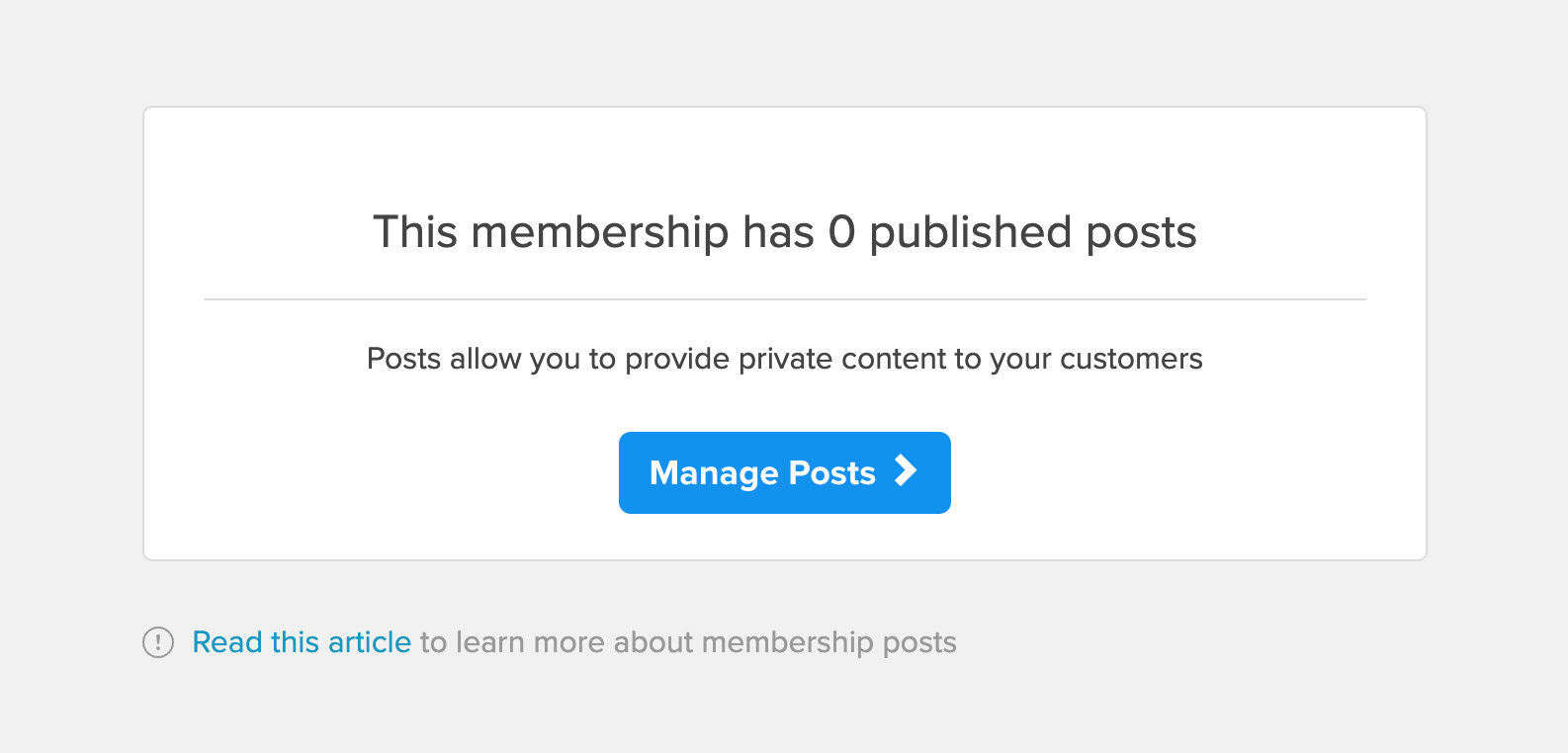
There is no option to sell access to a Discord community or Telegram channel through Payhip.
As for selling physical products - again you can add a product title, cover image, price and description, as well as the (optional) SKU and shipping weight.
Although the process of setting up a product for sale on Payhip is relatively straightforward, it is not as sleek as the product-creating experience on Gumroad.
Platform Customization
This is where Payhip wins. The customization options here are far more advanced than that of Gumroad.
If we look back to the Payhip dashboard there is an option to customize your store. Click this and you will be directed to set up your collection page.
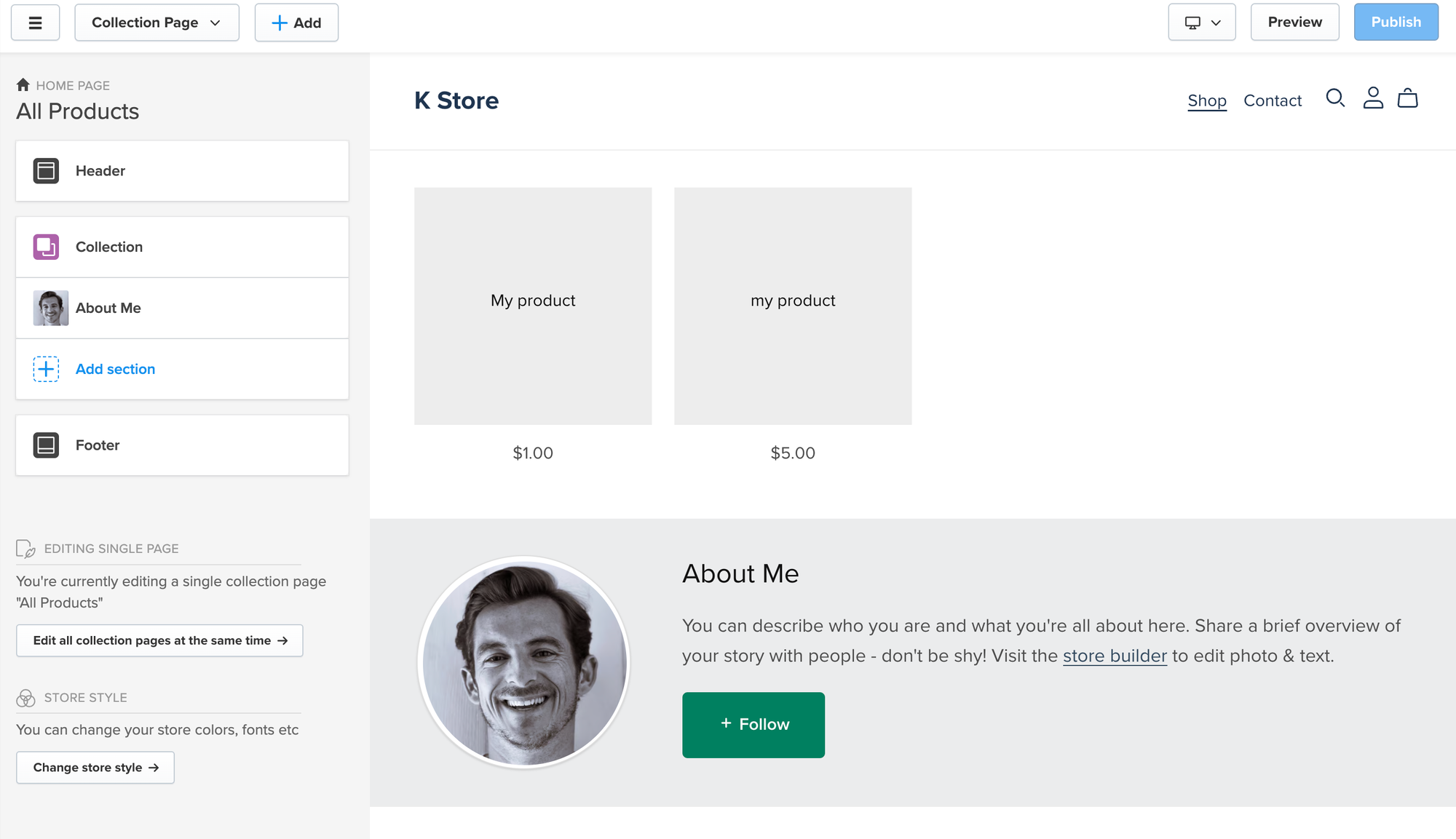
In this section, you can customize everything from your about me, to your store style with colors, fonts, buttons, favicons and themes, and even edit the aspect ratio, number of columns, and spacing of your page.
Payhip even goes further by allowing you to customize your products. For example, if you're selling a course, you can edit your course player settings with a choice of light theme or dark theme. And, you can choose the color of your background, buttons, text, and links. Plus, you can choose the font that you want on your course player.
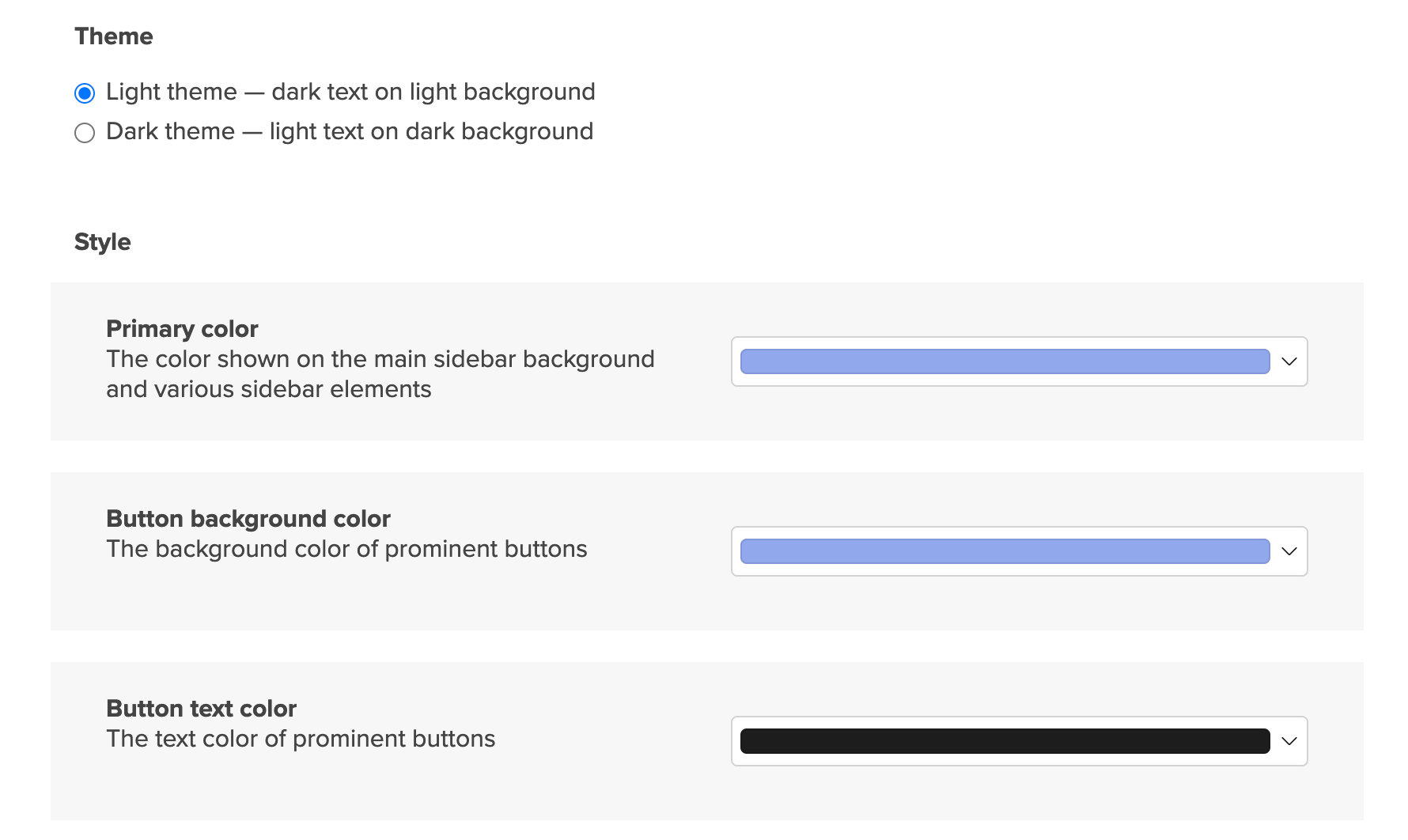
Customer Engagement Tools & Customer Management
A key feature of the Payhip platform is its marketing dashboard. Payhip describes this as 'a suite of powerful marketing tools'. Here you can add coupon codes to products, run sales, and set up affiliate marketing.
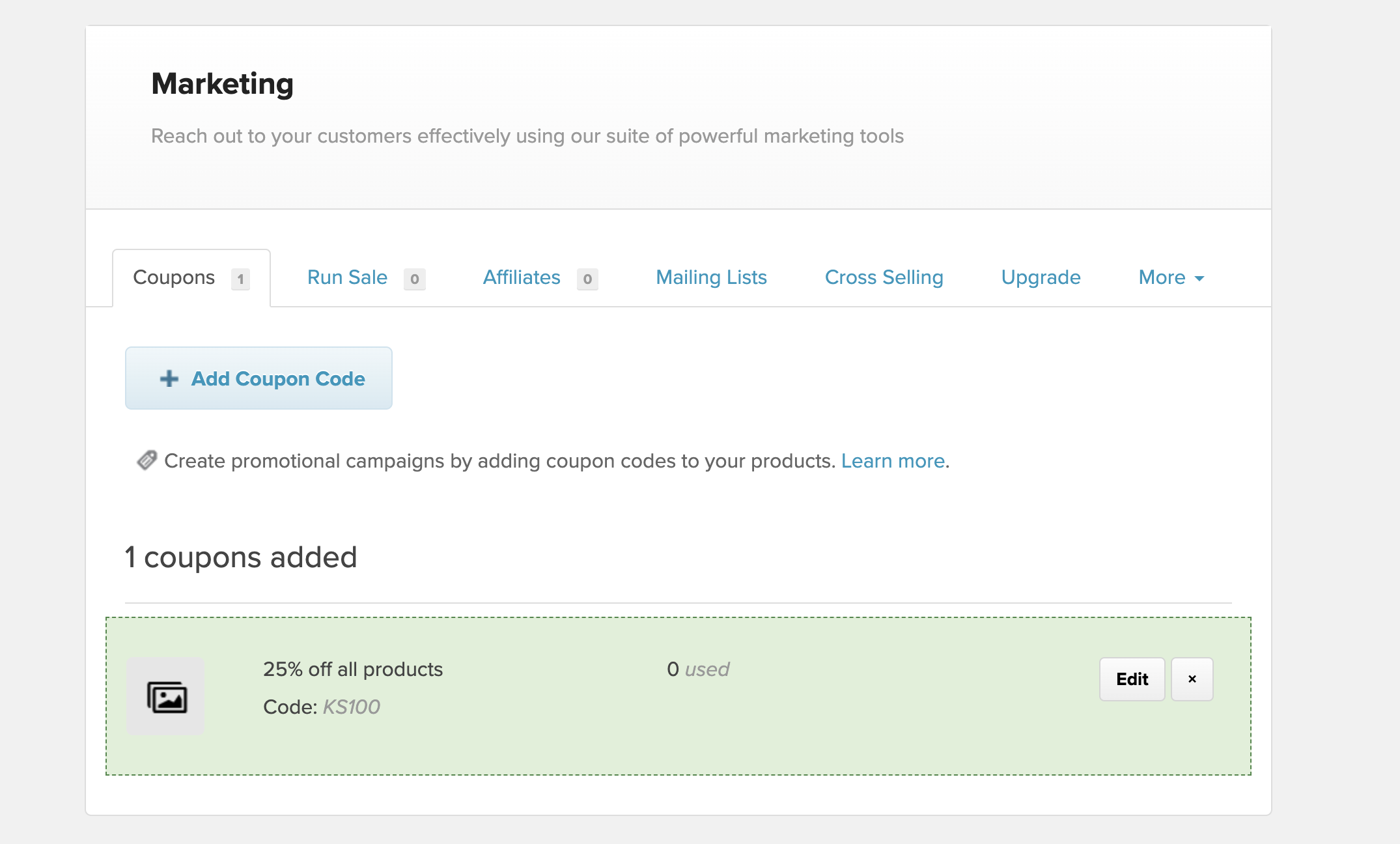
The platform also allows you to add cross-sell, which promotes other products to customers when they add one of your products to their store (for example, a buy-one-get-one half-price offer). Plus, you can set up mailing lists and create referral incentives.
As for customer management, that can be found under the 'customers' tab.
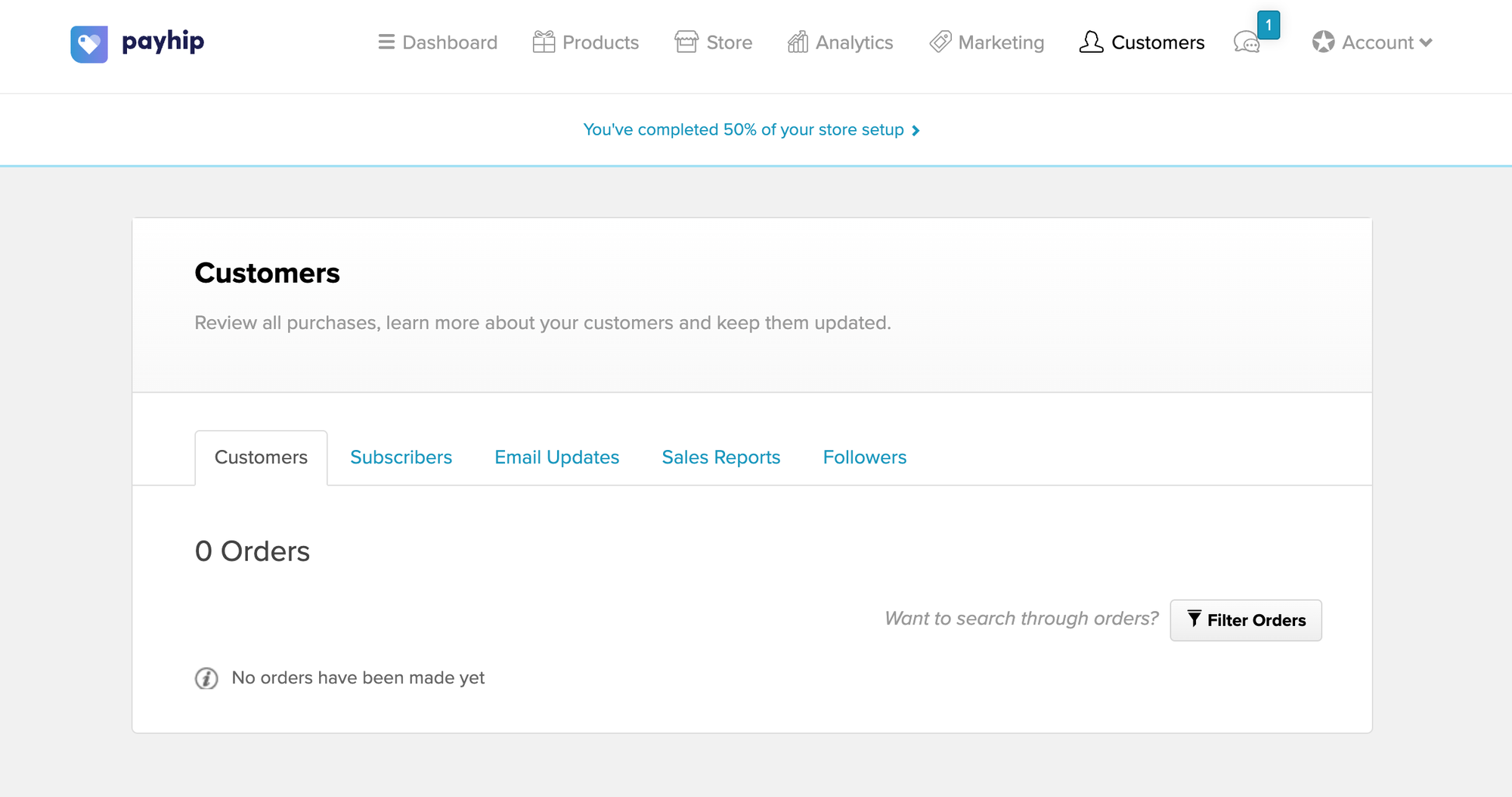
This is a pretty simple interface in which you can view your orders and filter by email address, products, date, ID, and order status. You can also review and manage your subscription customers here, send email updates, and access sales reports.
Customer Support
Much like Gumroad, customer support is where Payhip falls short. When searching for a support option, you come across the 'contact us' at the bottom of the screen, yet this simply leads to writing an email to the Payhip team.
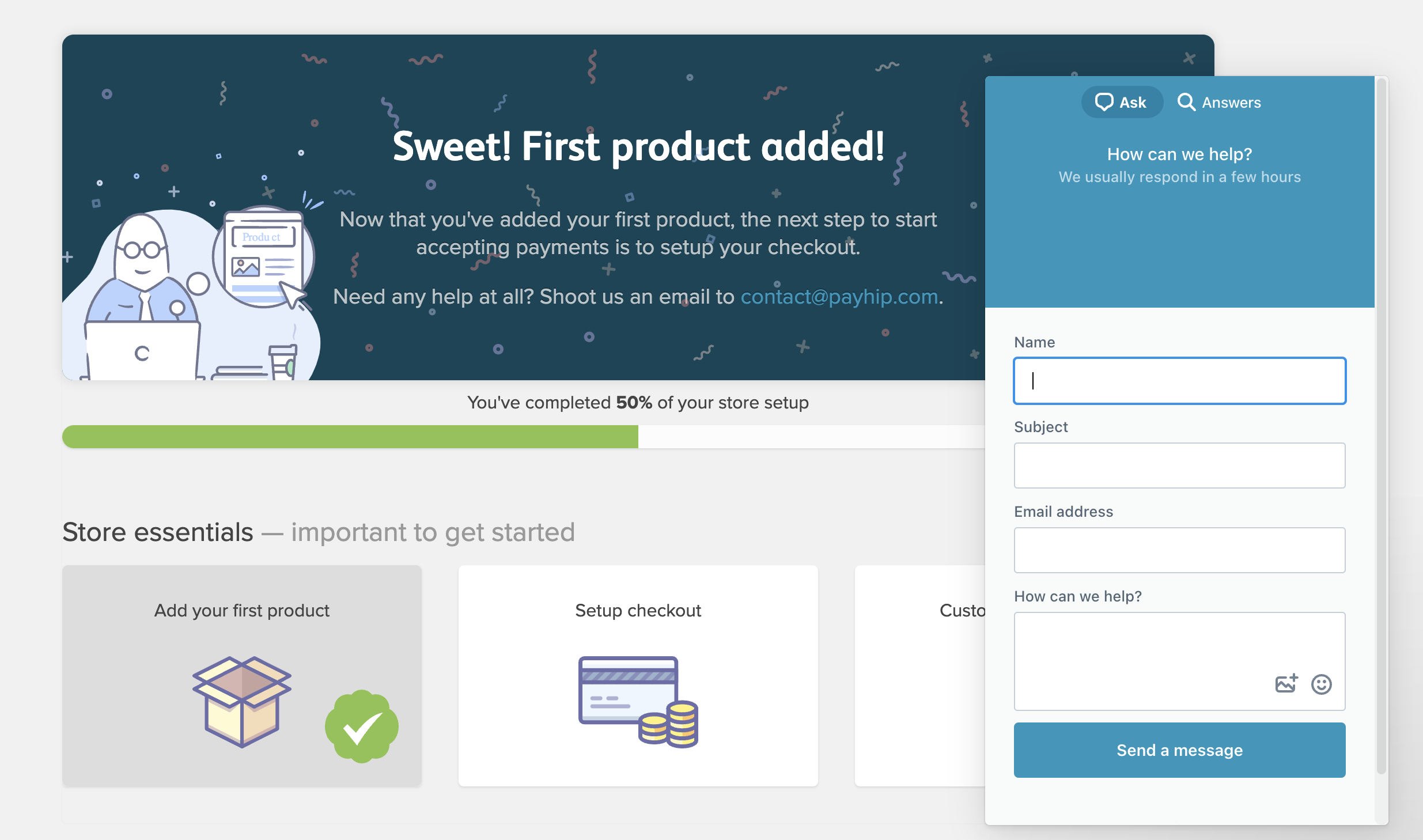
There is also a chat option which is accessed by clicking the blue speech bubble, but response time is listed as 'usually a few hours'. You can also check the 'answers' tab to find a solution to your problem there. Additionally, customer disputes are handled between the seller and buyer, with no help from Payhip.
How Much Does Payhip Cost?
Payhip has three pricing package options:
- Free Plan: No monthly charge and a 5% transaction fee on all sales
- Plus Plan: $29 monthly plus a 2% transaction fee on all sales
- Pro Plan: $99 monthly and no transaction fees
Gumroad vs. Payhip: Which is Better?
Now that we've established what both platforms offer and how creators can use them, you can likely see that they're pretty similar. Both companies can build landing pages to sell digital products easily, and both platforms come with some form of ecommerce marketing tools, like coupons and email marketing campaigns.
However, although these platforms are similar, they have some key differences. Let's recap how they differ with a look at the advantages and disadvantages of Gumroad and Payhip.
Advantages of Using Gumroad
- Ease-of-use
Gumroad is an incredibly easy-to-use platform. It will take a new user virtually no time to learn the platform and set up their account. - Email Marketing
One of the most significant advantages Gumroad has over Payhip is its email marketing capability. Users can import an existing email list into the platform or create a new one. - Data Collection
When a person purchases your product on Gumroad, you get to keep all their information. In comparison, some ecommerce sites, like Amazon, don't do this. Acquiring your customer information is excellent for building an email list and for better understanding who is buying your products (and, therefore, who you should target). - Gumroad Discover
Another fantastic advantage of Gumroad is the Gumroad Discover feature. The Gumroad Discover feature is the platform's algorithm. If your profile is a part of Gumroad Discover, your products will be recommended to prospective customers who are deemed to be a fit for your offering. This will allow you to grow your audience on Gumroad and generate more sales. You have to qualify to be a part of Gumroad Discover, but it's pretty simple to do so. There are two requirements: you have to have at least $10 USD from genuine sales and have to be verified by the platform's risk team. However, it is worth nothing that the platform takes an additional 10% fee from any sales generated from Gumroad Discover. - Detailed Statistics
You get access to your product statistics and metrics, including seeing data for:- How many times a product has been viewed and purchased
- Where sales are coming from (Google, website, email, etc.)
- How many sales you've made
Disadvantages of Using Gumroad
- Higher Price Point
Gumroad is clearly the more expensive option, with a fee twice the amount of Payhip. - Limited Customization
One of the reasons that Gumroad is so easy to learn and implement is that it's a simple system with limited customization options. This is an advantage at the beginning when you're starting, but it may feel like a disadvantage later on when you know the system and want to make improvements to your page. Most notably, your page will look much like other Gumroad pages, making it harder to stand out from the competition. - Payment Limitations
Gumroad has a few limitations to its payment policies that creators should be aware of:- You will only get paid out if you have a balance of $10 or more.
- You only get paid out once a week, on Fridays.
- You can be paid directly to your bank account if you're located in the US, Canada, UK, or Canada. However, all other countries will have to accept payment via PayPal.
Advantages of Using Payhip
- Lower Transaction Fees
As mentioned, Payhip only charges 5%, while Gumroad charges 10%. These numbers may seem small, but if you've sold $2,000 monthly, Payhip would take $100, while Gumroad would take $200. - Marketing Tools Available
Payhip offers a better range of marketing tools for its sellers than Gumroad. With Payhip, sellers can send customers discounts, participate in an affiliate program, and use built-in tools for upselling, referrals, and upgrade discounts. - Customizable
Payhip is a lot more customizable than Gumroad. If you want to put the effort in, your store can look much different than other Payhip accounts. You can add extra sections to your store pages (such as text blocks, a slideshow, and videos), add custom pages, and choose your font and coloring. - Instant Payouts
Payhip allows you to access your earnings whenever you'd like. - Bot Blocking
Payhip has systems in place to block out bots, so the traffic shown on your analytics page represents actual visitors. - EU & UK VAT Taxes
It can be confusing dealing with EU & UK VAT tax. As Payhip is a London-based company, it is competent in this area and handles this tax automatically with every applicable purchase.
Disadvantages of Using Payhip
- Lack of Email Marketing
Payhip doesn't have an email tool, so you'll have to do email marketing through a different platform. Note that Payhip integrates with many email tools (Active Campaign, AWeber, Campaign Monitor, ConvertKit, Drip, Elastic Email, EmailOctopus, GetResponse, Mad Mimi, MailerLite and MailerLite Classic, MailChimp, and SendFox). But it's still a disadvantage as you likely have to pay for these tools on top of paying for Payhip. - Basic Analytics
Some sellers complain that the analytics offered could be more in-depth and useful.
Alternatives to Gumroad and Payhip: Check Out Whop!
If you feel that Gumroad and Payhip aren't quite right for you, you're not alone. Despite the features outlined above, these ecommerce platforms have lackluster reviews online because they simply don't meet all the needs of creators and small business owners.
So, what's the solution?
Whop.
Whop is an all-in-one selling platform that acts as a digital marketplace for you to sell your products and services. Whop has over 8,000 active sellers, has sold over four million memberships, and has processed over $220,000,000 in sales.
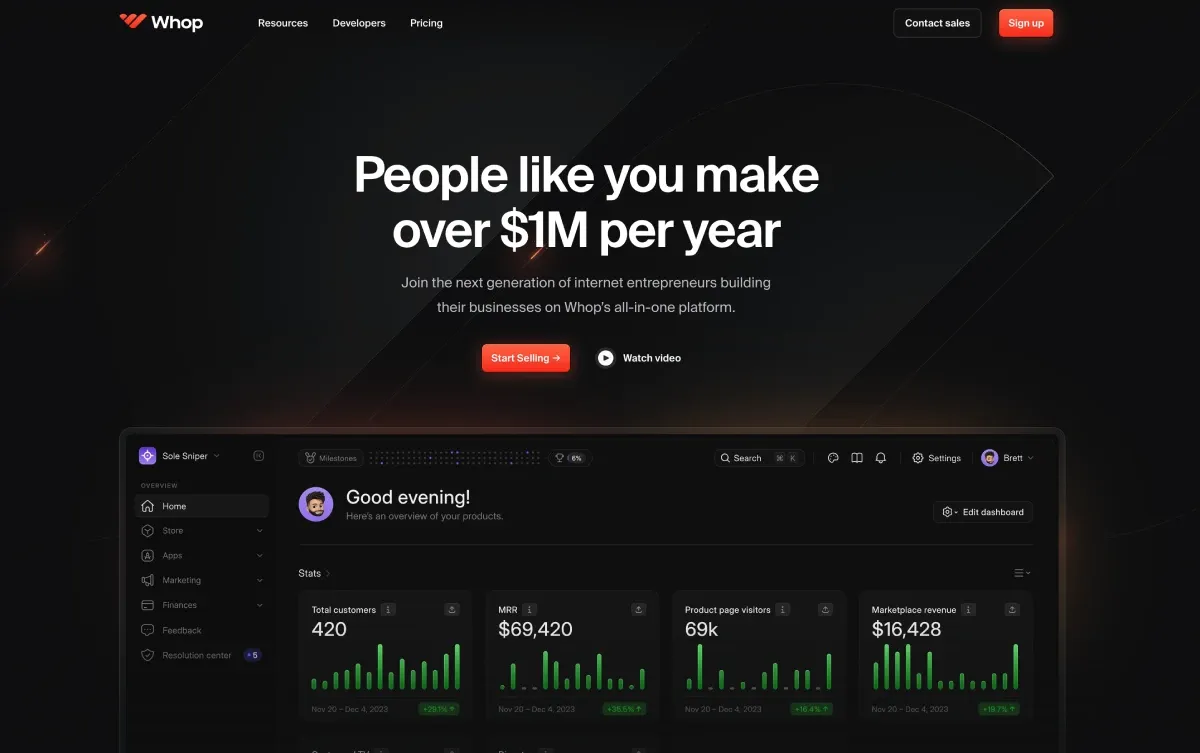
Here are some advantages of Whop that make it stand out against the competition of other platforms like Gumroad and Payhip:
- Affordable
Whop only charges a 3% transaction fee. - Unlimited Potential
Whop says it right on its homepage - you can sell anything here, from community access, to SaaS, downloadables, web apps, and more. - High-Performing Marketplace
It can be difficult to generate significant sales if you're a new creator who has yet to build a fanbase. Well, that's not something you need to worry about with Whop. We have a thriving marketplace and direct traffic to your page every day. - Mobile Phone Access
Gumroad and Payhip require you to access their platforms on a desktop. But, many creators are on the go and would like the option to operate from their phones. Whop has a mobile app for sellers, so you can make changes to your business without ever logging onto a computer. - Written Reviews
Every seller knows a review system is critical to buying customer trust. People feel more comfortable buying your products when they see others have purchased and reviewed them. Gumroad only has a star review system, which is limiting - there's no opportunity for customers to rave about your products this way! With Whop, customers can leave detailed, written reviews to help your business grow. - Unparalleled Customer Service
Whop's customer service is available 24/7. The average response time is less than five minutes, and 97% of customers report being satisfied with the support they receive. - Dispute Fighter & Resolution Center
Whereas Gumroad and Payhip leave sellers to handle refunds and disputes, Whop is with merchants every step of the way. Whop's Dispute Fighter tool and Resolution Center help sellers to resolve customer disputes and prevent future disputes by facilitating clear, open communication.
These are just a handful of the benefits Whop offers, but there is so much more. Check out this page for a more detailed look at Whop's benefits.
What's the Best Platform for Selling Digital Products?
Both Gumroad and Payhip are fine options; they have their advantages and disadvantages. However, as a business owner, you don't want to settle for 'fine' - you need the best. And that's why you need Whop.
Despite being around for several years, Gumroad and Payhip have poor customer reviews. Clearly, these platforms are not meeting the needs of customers and are not offering the level of support that sellers need.
Whop is built with the needs of creators in mind. The platform is affordable, easy to use, and customizable. Plus, Whop offers all the tools you need to grow your business.
Start selling today and see the value that Whop has to offer.
FAQs
Is it free to use an ecommerce platform?
All ecommerce platforms take a fee (monthly or transaction-based), as they provide a service to sellers.
What kind of digital products can I sell?
There is a whole range of digital products that you can sell, from Discord community access, to music, fonts, comics, sewing patterns, Chat GPT plugins, bots, eBooks, and more.
Why sell digital products?
When compared to physical products, digital products generally have higher profit margins, lower overhead costs, and a larger potential market.




